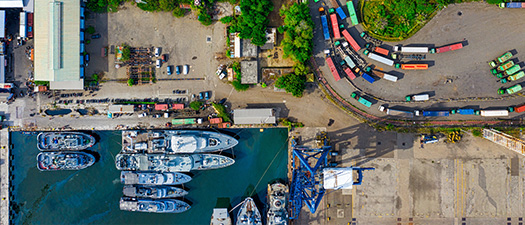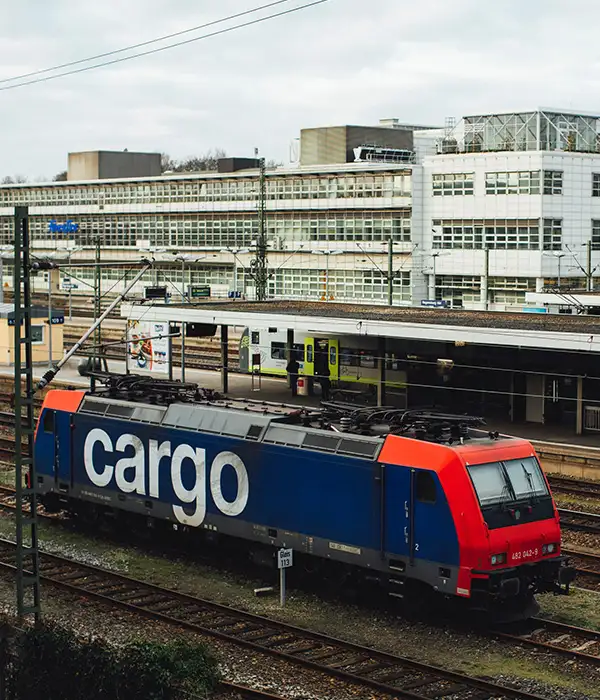Combined transport
WHY USE COMBINED TRANSPORT??
Intermodal transport consists in the use of various means of transport in order to optimize costs and delivery time. Thanks to the use of appropriate solutions, the goods can be easily moved from a truck to a ship or a train. Check how exactly combined transport works, what advantages it has and why it is worth using.

What is combined transport?
Combining different methods of transport makes it possible to increase the competitiveness of transport and logistics companies. They can transport larger quantities of products at the same time, which has a positive effect on the costs of such a solution. At the same time, combined transport allows you to pick up and deliver goods directly to the customer’s door.
The definition of combined transport is freight transport using more than one mode of transport. This means that the use of only the train and the ship is also subject to intermodal transport. However, it is much more common for products to end up on trucks. They can go anywhere.
According to European Directive 92/106 / EEC, the most environmentally friendly transport is transport with the help of railways, ships or inland navigation. However, road transport should only be used to cover the first and last section of the route (collection and delivery to the customer). The length of the road section should not exceed 100 km in the case of railways and 150 km in the case of a connection with sea transport.
Examples of combined transport
Examples of combined transport can be counted in thousands. Most often, the goods are picked up from the starting point with the help of a truck and transported to the transfer point. There the cargo is loaded onto a train or ship and thus covers the greatest part of the route. Near its destination, it is reloaded onto a truck to reach the customer’s warehouse.
An example is the transport of products from Poland to the United States. At the factory, ready-made elements are packed in a container adapted for easy reloading. This container is packed on a truck that goes to the nearest freight railway station. There, dozens of such goods are packed on a train that can economically reach the seaport in Gdańsk. The containers are then loaded onto a large transport vessel.
After reaching the shores of North America, the goods are repackaged on a train that travels large spaces to a specific state. There it is unloaded and the products are packed on the truck again to reach the customer’s warehouse.

24/7 SERVICES

EXPERIENCED STAFF

VERTERINARY AND EPIDEMIOLOGICAL INSPECTORATE

NON-STANDARRD DESTINATIONS
Advantages of combined transport
Does it make sense to constantly reload goods from one means of transport to another? Of course. The most important advantages of this solution include:
- reducing environmental pollution. An electric train produces much less harmful gases than a dozen trucks,
- increasing the efficiency of using available vehicles. Tractor units are suitable mainly for short journeys, mainly due to the limited capacity,
- flexibility in the organization of services,
- lower transport costs thanks to the use of more economical means of transport,
- reducing the number of transhipments thanks to the use of special transport containers,
- less dependence and overcrowding of the road network. Too many trucks on the routes cause congestion and delays in transport – especially in transit, stretching through many third countries.
As a result, the use of combined forwarding allows for savings, increased competitiveness and causes less damage to the environment.
Types of transport using different modes of transport
The use of several modes of transport to deliver goods is increasingly encountered mainly for economic reasons. Many types of this type of service have been developed. Each of them has specific possibilities and advantages. Which one is the most beneficial? Much depends on the goods and the route to be covered.

Intermodal transport
In the case of intermodal transport, all available modes of transport are used. What distinguishes this type of forwarding is the use of special containers. It can be a container adapted to various means of transport or a trailer that can be loaded onto a ship or train. Thanks to this, the goods are always packed in the same container, which facilitates its reloading and protects against damage.
Bimodal transport
We can talk about bimodal transport when two modes of transport are used (most often it will be road and rail, or road and sea). Exceptionally, however, there is no overloading of goods. The vehicle is transported with its cargo by ship or rail. Sometimes the driver also travels with the vehicle, in other cases the truck moves by itself, and another driver, provided by the company, is waiting on the spot.
Multimodal transport
Multimodal transport involves the transport of goods using at least two different modes of transport, while reloading goods from one loading unit to another. However, regardless of the number of transhipments and means of transport, one general contract for transport is always signed.
Combined transport
Combined transport is often referred to as intermodal European transport. In this system, the truck is transported by rail, inland waterway or coastal sea without reloading the goods. In the final stage, the products are brought back via road transport, which makes it possible to reach any place.
We work with any method of transport
Regardless of the mode of transport, goods crossing the border must be customs cleared. However, not all customs agencies deal with sea or rail transport. On the other hand, agents specialized in sea freight do not advise on road transport.
Embetim customs agency specializes in all means of transport. Our agents have knowledge of the current regulations regarding customs procedures used in land, sea, inland and rail transport.
We are also very familiar with the latest changes in the customs law that took place in the UK after Brexit. Thanks to this, we offer the widest services available on the market today. If you deal with international transport or you frequently import or export goods, it is worth starting cooperation with a competent customs agency, which is undoubtedly Embetim. Call us and check for yourself what we can suggest. We are happy to help you organize reliable and fast international transport.
The most commonly used connections for transporting goods
Due to the fact that the first and last section of the route is most often covered by road, goods are most often reloaded from trucks to trains or river or sea ships. Airplanes are very rarely used in combined transport, mainly due to the high cost of transport. However, in some cases, when fast transportation is needed, it is the main mode of transportation.
In the case of large land countries, such as China or Russia, goods are transferred onto ships. In the case of European countries, however, it is more often trucks that deliver cargo directly to sea or inland ports.
FAQ
Combined transport consists in the forwarding of goods by various modes of transport. In this way, you can achieve large savings and at the same time increase the flexibility of logistics.
We distinguish primarily intermodal transport. It is characterized by transporting products in special containers, adapted to various means of transport. Most often, these are containers that are easy to reload from a truck to a train or ship. In addition, there is also bimodal transport, where the goods travel by two means of transport and are reloaded in the traditional way between them. After all, in multimodal transport there can by any amount of reloading the cargo.
Combined transport does not release the goods from passing the appropriate border clearance procedure. Moreover, the activities and required documents may differ depending on the mode of transport. Therefore, the use of combined forwarding requires even better knowledge of customs regulations.
Unfortunately, most agencies specialize in one mode of transport. Agents can help either in road or sea transport. However, our agency Embetim is well-versed in the regulations regarding various means of transport.
Therefore, it is worth using our services when using combined transport. You will not have to contact various agents to ensure the safe passage of goods across borders. However, we will deal with all cases personally – our agencies have experience in customs clearance related to each means of transport.
New transhipment centers are being built all the time, which increases the attractiveness of intermodal transport. It has many advantages and benefits for logistics companies. Therefore, it is worth betting on this type of solutions today. Establishing cooperation with us is a good step in the logistics of the future.
